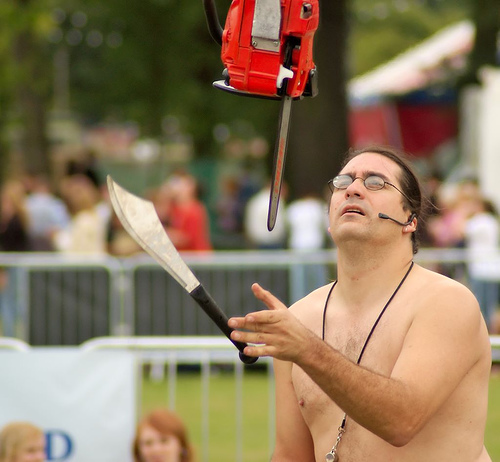Over the last two or three decades the power tool market has increasingly catered for the ambitious home user and DIY enthusiast. Once, chainsaws were used only by rained professionals such as tree surgeons, landscape gardeners and lumberjacks but nowadays almost anyone can pick up a low cost but relatively powerful chainsaw from their local DIY store. Chainsaws are dangerous; they must be handles with the utmost care and respect. Whilst the Health and Safety Executive acknowledges that inexperienced chainsaw users invite the greatest risk of injury, its statistics show that the majority of accidents amongst competent and experienced chainsaw users occur as a result of the user trying to save time and failing to adhere to good practice guidelines.

If you’ve purchased a chainsaw for home use – maybe to fell an unwanted tree or cut timber to size for a home renovation project – it is crucial that you take the time to learn how to use your chainsaw safely and properly. Here are 10 essential safety tips for chainsaw users.
Study the Operator’s Manual
Assume nothing about using a chainsaw safely – if you’ve never used one before it’s vital to read the operator’s manual provided by the manufacturer to fully familiarise yourself with the operation and safety features of your chainsaw.
Inspect Your Chainsaw Thoroughly Before You Use It
Make sure that your chainsaw is in perfect condition, free from wear and tear and that the on/off switch is responsive and that the safety feature are fully operational every time you want to use your chainsaw. A simple inspection before use can literally save life and limb.
Properly Maintain Your Chainsaw
After use and before you store your chainsaw ensure that it has been properly cleaned and has not been damaged in any way during use. Keep the chain properly lubricated, sharpened and correctly tensioned and if in any doubt about the condition of your chainsaw have it serviced professionally before using it again.
Avoid ‘Kickback’
85% od chainsaw accidents are the result of the chainsaw operator inadvertently coming into contact with the saw’s moving chain. One of the key factors in this is the phenomenon of ‘kickback’, where the teeth of the chain at the tip of the chainsaw’s blade suddenly catch on something causing the blade to kickback toward the operator. Modern chainsaws usually have safety features to minimise the danger of kickback, but being vigilant and using the chainsaw properly (e.g. not using the tip of the blade for cutting, and not attempting to cut any material other than wood) are of the utmost importance if kickback accidents are to be avoided.
Maintain a Firmly Balanced Position
It may be tempting in certain situations to adopt a cutting position that places you at risk of injury. Do not try to use your chainsaw with one hand only or adopt a stance in which unexpected kickback could result in loss of balance, knock you over or cause momentary loss of control of your chainsaw.
Secure Your Work Area
Make sure that the area in which you are working with your chainsaw is free from obstructions, trip-hazards etc. Also make sure that there is an effective ‘escape-route’ in the event of an emergency. Make sure that children and animals cannot inadvertently wander into the area in which you are working with the chainsaw. Minimise potential distractions (such as vibrating mobile phones) as much as possible.
Ensure You Are in a Fit State to Operate a Chainsaw
Just like motorway driving, tiredness can kill when operating a chainsaw. So can the effects of alcohol and medication. Do not attempt to use your chainsaw unless you are feeling 100% fit to do so and are able to commit your full concentration to the task at hand.
Protect Your Ears
A chainsaw in use emits around 110 decibels of noise – enough to damage hearing with prolonged exposure. Unless you enjoy the morning-after-a-rock-concert effect of ringing in your ears, it’s wise to protect them with a decent pair of ear defenders.
Use a Saw Horse
If you’re cutting up a tree trunk into logs for firewood or cutting timber to size for a DIY project, use a purpose-built saw horse for the job. This will hold the wood you are cutting securely and at the correct height. Never attempt to hold wood between your knees or feet when cutting it with a chainsaw.
Beware of Falling Timber
Whilst the majority of non-fatal chainsaw accidents occur as a result of the user coming into contact with the operational chainsaw, fatalities are more likely to occur as the result of falling tree limbs or tree trunks that have been felled without due care. Safely cutting down trees requires a degree of specialist skill; if you are in any doubt whatsoever about removing a tree using a chainsaw, consult a professional.
Citations:
- Photograph by Janek Mann (via Flickr) [CC BY 2.0]
For peace of mind, head to Buxton’s online store – home to an excellent selection of chainsaw trousers and other garden and forestry equipment.

